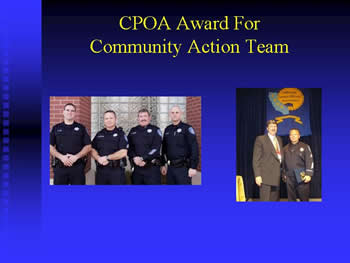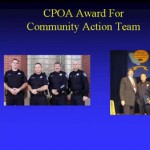City Sued for Fighting Crime

The Antioch Police Community Action Team has been awarded by the California Peace Officers Association, but sued by Bay Area advocacy groups for African-American Section 8 tenants.
By Dave Roberts
For the first decade that Walter Ruehlig lived in Antioch his neighborhood was “just as quiet as could be,” he said. “I would always tell people how blessed I felt. I couldn’t even recall one instance of complaining to a neighbor about loud music. Then all of a sudden all hell broke loose.”
That hell began around five years ago. He had a car stolen out of his driveway. Someone attempted to break in through the back door. Two bicycles were stolen. A neighbor threatened to kill his wife and dog. A house down the street was the scene of drug activity with people coming and going at all hours, loud parties late into the night, people smoking marijuana on the roof, garbage strewn in the front yard. Neighbors placed about 20 calls to the police. Another house contained a juvenile who attempted to rob a kid of his iPod, then shot him in the back when he ran.
Another teen in that house spewed a string of expletives at Ruehlig when he confronted the juvenile about leaving a shopping cart in the street. “He said, ‘You step one foot further, m-f-er, you’re a dead man,’” said Ruehlig. “I called the police and they came out. They were getting call after call.”
Unfortunately, Ruehlig’s neighborhood was not alone. In 2007 Antioch suffered a 31 percent increase in violent crime – the largest increase of any big city in California – at a time when violent crime was actually decreasing in many large cities.
The increase in crime occurred around the same time that federally subsidized Section 8 rentals significantly increased in the city – the 1,900 rentals were the second largest of any city in Contra Costa County. When the real estate market was booming, housing was seen as a good investment. Absentee owners rented out their homes – some worth $700,000-$800,000 at the time (less than half that now) – to Section 8 tenants because the landlords were guaranteed a monthly check from Uncle Sam. The federal program pays about two-thirds of the rent with the tenant picking up the rest.
The problem was that the understaffed Housing Authority of the County of Contra Costa (HACCC) only conducted cursory background checks on the tenants with few or no follow-ups. Residents who lived near problem residences in which they suspected the tenants of receiving Section 8 vouchers, tried to complain to the HACCC, but were often unable to get through the phone system or left messages that weren’t returned. They then complained to city officials, who pressured HACCC and also established a community policing team of four officers, known as the Community Action Team (CAT), in July 2006.
Instead of the reactive enforcement of police officers being called to a residence numerous times, issuing a warning or citation and filing a report each time, only to be called back again and again, it’s been the CAT’s job to take a proactive approach to find ways to deal with problem residents. That has included trying to find ways to help tenants find support services for their problems as well as determining whether they are violating Section 8 regulations, such as having an unauthorized person in the residence, and reporting that to the landlord and HACCC.
Residents like Ruehlig have been grateful for the help. “We heard from the CAT Team that they thought it appeared the ending was coming (for the problems at one house),” he said. “Sure enough, they just left. I think so much pressure was put on them, they got tired of the calls and the landlord. I am convinced that this sort of targeted attention is the only thing that can drive people out when the police are like a tattoo all over them. Legally so. They don’t come out unless you call them. The CAT Team gave us their number and said, ‘Call me.’ I think that’s what did the trick. Ever since then it’s been a vastly improved neighborhood. It ain’t what it was 10 years ago, but for a while it was the Wild West.”
Improvements were also made at HACCC after it was fined by the Department of Housing and Urban Development for mismanagement in January 2007, the HACCC director was replaced in March 2007 and an HACCC office was opened in Antioch.
But over the course of the next year while complaints to police and city officials from residents about problem neighbors decreased, they were replaced by complaints from advocates for African-American Section 8 families, alleging police harassment. In December 2007 a 38-page report entitled “Policing Low-Income African-American Families in Antioch, Racial Disparities in ‘Community Action Team’ Practices” was issued by Bay Area Legal Aid and Public Advocates Inc. It states that although African-Americans total 14 percent of Antioch’s population (representing a doubling from 2000-06), they comprise 56 percent of the city’s Section 8 tenants.
After reviewing 1,150 pages of police and HACCC reports on Section 8 households, the report charges that “African-American households in Antioch are approximately four times more likely than white households to be the subject of a CAT case, subjected to a search or investigated by the CAT, searched or investigated by the CAT based on a purely non-criminal complaint, subjected to a letter from the Police Department to their landlord complaining of their conduct. In short, there is reason to believe that scrutiny of Section 8 families may serve as a proxy for scrutiny of low-income African-American families.
“CAT practices overselect African-American families, even within the disproportionately African-American Section 8 population. While 56 percent of all Section 8 families in Antioch are African-American, 70 percent of the families about which CAT has submitted complaints to the Housing Authority are African-American. The explanation for the disparity does not appear to lie in the illegitimate conduct of the tenants.”
The city attorney responded in a press release that the CAT Team has no “racial focus” and that it is merely attempting to deal with properties that “include a high number of calls for service to the Police Department, suspected criminal activity, substandard housing or other structures, lack of utilities or sanitation facilities, vagrants in abandoned buildings, and/or lack of property maintenance. About two-thirds of complaints concerned homes later determined to be Section 8 properties, in which some of the tenants aren’t following the rules of the program such as engaging in drug-related and unlawful behavior.
“The City and Police Department recognize that the vast majority of Section 8 residents do not generate calls for service to the Police Department or neighborhood complaints. The City looks forward to continuing to work with the Housing Authority to ensure that the many needy, disabled and elderly persons who have been on the waiting list for Section 8 assistance for years are not overlooked in favor of those who are unwilling to follow the rules of the Section 8 program.”
Three lawsuits were filed against the city alleging police discrimination against African-American Section 8 tenants. Recently one suit, on behalf of an African-American woman, lost in a jury trial; and another, on behalf of a Section 8 landlord was withdrawn before going to trial after the city established that the CAT Team wasn’t within a quarter-mile of the landlord’s home during the alleged incidents.
The third suit, which is backed by the ACLU and the Impact Fund, has been filed on behalf of four African-American Section 8 women, who could receive monetary damages if they win. It has also been granted class-action status on behalf of 1,000 unnamed African-American Antioch residents, who would not receive damages. A trial date has yet to be set.
City officials are encouraged by their victories in the other two suits, and many residents are glad they have decided to fight. “There’s a small percentage of homes that are just wrecking whole neighborhoods,” said Ruehlig. “I am not against Section 8. I am sure there’s many good aspects to the program. But it’s a program where many have wreaked havoc.”
the attachments to this post:






















i can confirm that the last 3-4 all hell broke loose in my street. even i am just around the corner of sycamore and spanos, my street was always quiet.
now we had 3 shootings, the area is trashed up. i used to clean ones a month, but now i would need 3 trash cans to clean things up. many of my neighbors have moved away. we now have registered “schools”, and “families” with 5,6 ore even more kids, all the same age i may add. verbal fighting (if one takes the word f… , n….., and motherf.. out of their vocabulary, they would have nothing to say to each other. loud music, many many visitors till the morning hours.
with other words, everything is falling apart.
we need some kind of rental control. business license for “investors” who rent out houses for profit. on top of it an extra fee with every contract they close/ sign.
the city needs to re-hire a building inspector.
I live in the same area, and agree with you wholeheartedly.